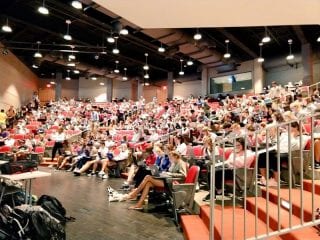Network Technology Upgrades Improve Testing and Teaching Experience for Fulbright College
 Heading into the new year there are many reasons to celebrate, including reaching a big project milestone for the University of Arkansas’ Achieve IT: Network Foundations project team and the J. William Fulbright College of Arts and Sciences.
Heading into the new year there are many reasons to celebrate, including reaching a big project milestone for the University of Arkansas’ Achieve IT: Network Foundations project team and the J. William Fulbright College of Arts and Sciences.
Upgrades within the Arkansas Union, along with the completion of all building upgrades within Fulbright College, means that this project – to strengthen the wired and wireless network across campus – is now more than 50 percent complete.
“Thanks to IT Services, Fulbright College now has all 23 of its buildings fully upgraded and our network is in better shape than it has ever been before,” said Todd Shields, dean of Fulbright College. “Thanks to this upgrade, our college is even more equipped for research, innovation and student success.”
But building a stronger network at the university is about more than just new equipment, it is also about providing practical benefits for both students and faculty in the classroom.
And the benefits of a stronger network are already being experienced by Fulbright College faculty and students. Students enrolled in a Biological Science class this fall had the opportunity to test online, in class for the first time ever because of upgrades within Hillside Auditorium.
For biological sciences instructor John Shadwick, this meant providing in-class, online tests for the first time ever for all 1,200 students enrolled in his Principles of Biology course.
Previously, the network in this building could only support 350 devices at one time, which led instructors like Shadwick, with large lecture classes, to use outside services for online testing.
For the past few semesters, Shadwick used a proctoring service that required students to test online in locations outside of class during a 24-hour window. This academic year, the cost for using this service would reach new heights at nearly $90,000 (broken down into $15 per student, times five tests each).
Finding a more cost-effective option meant bringing exams back to the classroom so that Shadwick and his team of graduate assistants could administer these without the use of an outside service. This became a viable option after the network team upgraded both the wired and wireless equipment within Hillside Auditorium.
Today, the building’s network can support up to 1,350 devices. A fast and reliable internet means that an auditorium of more than 450 students can now test at the same time in the same location with ease.
“The testing experience was more successful than I thought it would be and way easier than previous methods,” Shadwick said.
Not only did moving to this model save money, it also saved time.
“Before, I had to be available to answer test questions for an entire 24-hour period. Now, everything is done during the lecture period. Students even receive their test scores upon submission,” Shadwick said. “The students are happier, and I feel like I have so much time left in my day.”
In addition to an improved testing experience, the class received additional support from IT Services and Global Campus throughout the semester. On test days, staff from Teaching Innovation and Pedagogical Support (TIPS) were onsite to provide loaner computers and offer tech help if needed.
Kathryn Zawisza, director of academic technology and innovation, said Shadwick’s experience is now helping the TIPS team assist other instructors who are making this available to their classes.
“We’re here to be a resource for anyone who teaches as they strive to meet the needs of students in creative and innovative ways,” Zawisza said. “If another instructor needs online testing support, we invite them to email us at tips@uark.edu. We’re happy to help.”
With a few more test scores now in gradebooks, Shadwick hopes to encourage fellow faculty members to reach out.
“When you join the faculty, you often feel alone and don’t realize the resources that are available to you as an instructor. This university has great resources in IT Services and Global Campus,” Shadwick said. “If you have an idea, talk to the team about your ideas and technology needs, there’s a lot of support available.” For Shadwick and others, the Network Foundations project has encouraged collaboration throughout campus as both academics and support services have worked to improve technology on campus.
“We are always excited to partner with IT Services and collaborate for the betterment of our students and all who call Fulbright College home,” said Simon Chua, Fulbright College’s assistant dean for finance and administration, who supervises the college’s technology team. “It has always been a pleasure working with the central IT Services team and we look forward to continuing to partner with them all in future projects they pioneer.”
Since August, 60 campus locations have been upgraded with another 50 scheduled for completion by winter break. And as of November, more than 2,600 new wireless access points have been installed during the project. These are now handling more than 12,500 concurrent connections each day.
“We’re excited by the progress of this project,” said Elon Turner, director of infrastructure systems for IT Services. “We expect our momentum will only increase as the fall semester comes to a close.”
An interactive map is available online for the campus community to follow project progress. The Network Foundations project is expected to be completed by the end of January 2019.
View a list of completed buildings and learn more on the Network Foundations website.
A version of this this story also appeared in the University of Arkansas’ Newswire publication.
CONTACTS
Chris Butler, director of communications University Information Technology Services 479-387-3836, chrisb@uark.edu
Jennifer Brown, communications strategist Information Technology Services 479-387-3849, jennb@uark.edu

